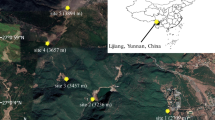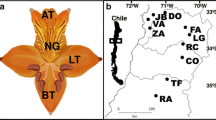Summary
Individual plants in gynodioecious populations ofPhacelia linearis (Hydrophyllaceae) vary in flower gender, flower size, and flower number. This paper reports the effects of variation in floral display on the visitation behaviour of this species' pollinators (mainly pollen-collecting solitary bees) in several natural and three experimental plant populations, and discusses the results in terms of the consequences for plant fitness. The working hypotheses were: (1) that because female plants do not produce pollen, pollen-collecting insects would visit hermaphrodite plants at a higher rate than female plants and would visit more flowers per hermaphrodite than per female; and (2) that pollinator arrival rate would increase with flower size and flower number, the two main components of visual display. These hypotheses were generally supported, but the effects of floral display on pollinator visitation varied substantially among plant populations. Hermaphrodites received significantly higher rates of pollinator arrivals and significantly higher rates of visits to flowers than did females in all experimental populations. Flower size affected arrival rate and flower visit rate positively in natural populations and in two of the three experimental populations. The flower size effect was significant only among female plants in one experimental population, and only among hermaphrodites in another. The effect of flower number on arrival rate was positive and highly significant in natural populations and in all experimental populations. In two out of three experimental populations, insects visited significantly more flowers per hermaphrodite than per female and visited more flowers on many-flowered plants than on few-flowered plants, but neither effect was detected in the third experimental population. Because seed production is not pollen-limited in this species, variation in pollinator visitation behaviour should mainly affect the male reproductive success of hermaphrodite plants. These findings suggest that pollinator-mediated natural selection for floral display inP. linearis varies in space and time.
Similar content being viewed by others
References
Ågren, J., Elmqvist, T. and Tunlid, A. (1986) Pollination by deceit, floral sex ratios and seed set in dioeciousRubus chamaemorus L.Oecologia 70, 322–38.
Arroyo, M. T. K. and Raven, P. H. (1975) The evolution of subdioecy in morphologically gynodioecious species ofFuchsia sect.Encliandra (Onagraceae).Evolution 29, 500–11.
Atsatt, P. R. and Rundel, P. W. (1982) Pollinator maintenance vs. fruit production: Partitioned reproductive effort in subdioeciousFuchsia lycioides.Ann. Miss. Bot. Gard. 69, 199–208.
Ayres, M. P. and Thomas, D. L. (1990) Alternative formulations of the mixed-model ANOVA applied to quantitative genetics.Evolution 42, 221–6.
Bell, G. (1985) On the function of flowers.Proc. Roy. Soc. Lond. B 224, 223–65.
Bertin, R. I. (1988) Paternity in plants. InPlant Reproductive Ecology (J. Lovett Doust and L. Lovett Doust, eds) pp. 30–59. Oxford University Press, Oxford, UK.
Bierzychudek, P. (1987) Pollinators increase the cost of sex by avoiding female flowers.Ecology 68, 444–7.
Campbell, D. R. (1989) Measurements of selection in a hermaphrodite plant: Variation in male and female reproductive success.Evolution 43, 318–34.
Charlesworth, D. and Charlesworth, B. (1987) The effect of investment in attractive structures on allocation to male and female function in plants.Evolution 41, 948–68.
Charnov, E. L. and Bull, J. J. (1986) Sex allocation, pollinator attraction, and fruit dispersal in cosexual plants.J. Theor. Biol. 118, 321–5.
Cruzan, M. B., Neal, P. R. and Willson, M. F. (1988) Floral display inPhyla incisa: Consequences for male and female reproductive success.Evolution 42, 505–15.
Elmqvist, T., Ågren, J. and Tunlid, A. (1988) Sexual dimorphism and between-year variation in flowering, fruit set and pollinator behavior in a boreal willow.Oikos 53, 58–66.
Epperson, B. K. and Clegg, M. T. (1987) Frequency-dependent variation for outcrossing rate among flower-color morphs ofIpomoea purpurea.Evolution 41, 1302–11.
Galen, C. (1989) Measuring pollinator-mediated selection on morphometric floral traits: Bumblebees and the alpine sky pilot,Polemonium viscosum. Evolution 43, 882–90.
Galen, G. and Newport, M. E. A. (1987) Bumble bee behavior and selection on flower size in the sky pilot,Polemonium viscosum.Oecologia 74, 20–23.
Galen, G. and Stanton, M. L. (1989) Bumble bee pollination and floral morphology: Factors influencing pollen dispersal in the alpine sky pilot,Polemonium viscosum (Polemoniaceae).Am. J. Bot. 76, 419–26.
Geber, M. A. (1985) The relationship of plant size to self-pollination inMertensia ciliata.Ecology 66, 762–72.
Gillett, G. W. (1962) Evolutionary relationships ofPhacelia linearis.Brittonia 14, 231–6.
Herrera, C. M. (1987) Components of pollinator ‘quality’: a comparative analysis of a diverse insect assemblage.Oikos 50, 79–90.
Herrera, C. M. (1988) Variation in mutualisms: The spatiotemporal mosaic of a pollinator assemblage.Biol. J. Linn. Soc. 35, 95–125.
Horvitz, C. C. and Schemske, D. W. (1990) Spatiotemporal variation in insect mutualists of a neotropical herb.Ecology 71, 1085–97.
Kalisz, S. (1986) Variable selection on the timing of germination inCollinsia verna (Scrophulariaceae).Evolution 40, 479–91.
Kay, Q. O. N., Lack, A. J., Bamber, F. C. and Davies, C. R. (1984) Differences between sexes in floral morphology, nectar production and insect visits in a dioecious species,Silene dioica.N. Phytol. 98, 515–29.
Lewis, D. (1941) Male sterility in natural populations of hermaphrodite plants.N. Phytol. 40, 56–63.
Lloyd, D. G. (1974) Theoretical sex ratios in dioecious and gynodioecious angiosperms.Heredity 32, 11–34.
Lloyd, D. G. (1988) Benefits and costs of biparental and uniparental reproduction in plants. InThe Evolution of Sex (R. E. Michod and B. R. Levin, eds), pp. 233–52. Sinauer Associates, Sutherland, MA, USA.
Moffet, J. O. and Smith, L. S. (1972) Honey bees as pollinators of hybrid cotton.Environ. Entomol. 1, 368–70.
Parker, F. D. (1981) Sunflower pollination: Abundance, diversity, and seasonality of bees on male-sterile and male-fertile cultivars.Environ. Entomol. 10, 1013–17.
Pleasants, J. M. and Chaplin, S. J. (1983) Nectar production rates ofAsclepias quadrifolia: Causes and consequences of individual variation.Oecologia 59, 232–8.
Primack, R. B. and Kang, H. (1989) Measuring fitness and natural selection in plants.Ann. Rev. Ecol. Sys. 20, 367–96.
Rice, W. R. (1989) Analyzing tables of statistical tests.Evolution 43, 223–5.
SAS Institute (1987)SAS/STAT Guide for Personal Computers. SAS Institute, Cary, NC, USA.
Schemske, D. W. (1980) Evolution of floral display in the orchidBrassavola nodosa.Evolution 34, 489–93.
Schemske, D. W. and Horvitz, C. C. (1984) Variation among floral visitors in pollination ability: A precondition for the evolution of mutualism specialization.Science 225, 519–21.
Schmid-Hempel, P. and Speiser, B. (1988) Effects of inflorescence size on pollination inEpilobium angustifolium.Oikos 53, 98–104.
Schmitt, J. (1983) Flowering plant density and pollinator foraging inSenecio.Oecologia 60, 97–102.
Schoen, D. J. and Clegg, M. T. (1985) The influence of flower color on outcrossing rate and male reproductive success inIpomoea pupurea.Evolution 39, 1242–9.
Stanton, M. L. (1987) Reproductive biology of petal color variants in wild populations ofRaphanus sativus: I. Pollinator response to color morphs.Am. J. Bot. 74, 178–87.
Stanton, M. L. and Preston, R. E. (1988a) Ecological consequences and phenotypic correlates of petal size variation in wild radish,Raphanus sativus (Brassicaeae).Am. J. Bot. 75, 528–9.
Stanton, M. L. and Preston, R. E. (1988b) A qualitative model for evaluating the effects of flower attractiveness on male and female fitness in plants.Am. J. Bot. 75, 540–4.
Stanton, M. L., Snow, A. A. and Handel, S. N. (1986) Floral evolution: Attractiveness to pollinators increases male fitness.Science 232, 1625–7.
Stanton, M. L., Snow, A. A., Handel, S. N. and Bereczky, J. (1989) The impact of a floral color polymorphism on mating patterns in experimental populations of wild radish (Raphanus raphanistrum L.).Evolution 43, 335–46.
Sutherland, S. (1987) Why hermaphroditic plants produce many more flowers than fruits: Experimental tests withAgave mckelveyana.Evolution 41, 750–9.
Sutherland, S. and Delph, L. F. (1984) On the importance of male fitness in plants: Patterns of fruit set.Ecology 65, 1093–1104.
Tepedino, V. J. and Parker, F. D. (1982) Interspecific differences in the relative importance of pollen and nectar to bee species foraging on sunflowers.Environ. Entomol. 11, 246–50.
Thomson, J. D. (1988) Effects of variation in inflorescence size and floral rewards on the visitation rates of traplining pollinators ofAralia hispida.Evol. Ecol. 2, 65–76.
Waser, N. M. (1983) The adaptive nature of floral traits: Ideas and evidence. InPollination Biology (L. Real, ed.), pp. 241–85. Academic Press, NY, USA.
Waser, N. M. and Price, M. V. (1981) Pollinator choice and stabilizing selection for flower color inDelphinium nelsonii.Evolution 35, 376–90.
Waser, N. M. and Price, M. V. (1982) A comparison of pollen and fluorescent dye carry-over by natural pollinators ofIpomopsis aggregata (Polemoniaceae).Ecology 63, 1168–72.
Willson, M. F. and Price, P. W. (1977) The evolution of inflorescence size inAsclepias (Asclepiadaceae).Evolution 31, 495–511.
Young, H. J. and Stanton, M. L. (1990) Influences of floral variation on pollen removal and seed production in wild radish.Ecology 71, 536–47.
Author information
Authors and Affiliations
Rights and permissions
About this article
Cite this article
Eckhart, V.M. The effects of floral display on pollinator visitation vary among populations ofPhacelia linearis (Hydrophyllaceae). Evol Ecol 5, 370–384 (1991). https://doi.org/10.1007/BF02214154
Issue Date:
DOI: https://doi.org/10.1007/BF02214154




